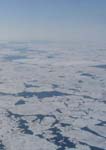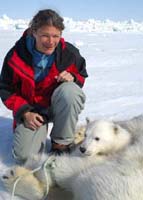Jodie Pongracz, M.Sc. Candidate
Email: pongracz@ualberta.ca
A habitat assessment of polar bears (Ursus maritimus) in the Southern Beaufort Sea
Polar bears (Ursus maritimus) are a circumpolar species distributed among 19 subpopulations.  They are a species of Special Concern in Canada1, Threatened in the United States2, and Vulnerable internationally3. These designations are assigned based on projected declines in sea ice and their predicted negative impact on polar bear physical condition, abundance, and distribution 1,2,3. The impact of climate change on ice conditions varies between geographic regions and it is uncertain how predicted patterns of seasonal ice declines and loss will affect the different polar bear subpopulations or their distribution and movements 4,5,6.
They are a species of Special Concern in Canada1, Threatened in the United States2, and Vulnerable internationally3. These designations are assigned based on projected declines in sea ice and their predicted negative impact on polar bear physical condition, abundance, and distribution 1,2,3. The impact of climate change on ice conditions varies between geographic regions and it is uncertain how predicted patterns of seasonal ice declines and loss will affect the different polar bear subpopulations or their distribution and movements 4,5,6.
Polar bears adapted to sea ice habitat from which they hunt, travel, mate 7,8, and in some cases den on9. They primarily prey on seals, and their survival and reproduction is dependent on acquiring sufficient fat reserves during late spring and early summer10. Ringed seals (Phoca hispida) are primary prey for polar bears throughout their range in the Canadian Arctic 8,11.  Seal distribution, and therefore polar bear distribution, is strongly influenced by shore leads, polynyas, areas of annual and multi-year sea ice, and patterns of freeze-up and break-up 12. Annual ice overlaying the continental shelf is the most biologically productive polar bear habitat, yielding greater seal abundances than deeper waters of the polar basin4. Regional and annual variation in the distribution, abundance, and characteristics of sea ice have significant effects on polar bear reproduction and survival 10,13,14.
Seal distribution, and therefore polar bear distribution, is strongly influenced by shore leads, polynyas, areas of annual and multi-year sea ice, and patterns of freeze-up and break-up 12. Annual ice overlaying the continental shelf is the most biologically productive polar bear habitat, yielding greater seal abundances than deeper waters of the polar basin4. Regional and annual variation in the distribution, abundance, and characteristics of sea ice have significant effects on polar bear reproduction and survival 10,13,14.
The Southern Beaufort Sea is experiencing substantial declines in sea ice extent 15,16, and the subpopulation of polar bears in this region is expected to be of the most affected by climate warming 17. The recent trend of later sea ice freeze-up and earlier sea ice break-up is forcing Southern Beaufort Sea polar bears to either spend the summer on sea ice over deep waters where productivity is low18 or on land where food is limited 19. Changes in sea ice extent and condition in the Southern Beaufort Sea have been associated with declines in cub survival20 and instances of ice clawing, cannibalism, drowning, and starvation 10,19,21. In general, an understanding of how polar bears have responded to their changing environment is lacking.
Sea ice habitat is a resource for polar bears in terms of providing a platform to hunt from, travel over, den on, and mate on. Sea ice is not uniform but highly variable and dynamic. What makes a good den or  hunting site depends, in part, on the ice characteristics of the area (i.e. ice concentration/coverage, stage of development, floe size). Determining which features of sea ice and sea ice habitat (i.e. bathymetry, distance to land) are selected for provides information on how polar bears meet survival requirements, as it assumes that they preferentially select high quality resources over those of lower quality. One way to evaluate habitat selection involves use of resource selection functions. Resource selection functions (RSFs) predict the relative probability of use of a habitat unit 22, otherwise stated, they predict the probability of a bear using an area based on the habitat features of the area, and are derived from analyzing observed habitat selection.
hunting site depends, in part, on the ice characteristics of the area (i.e. ice concentration/coverage, stage of development, floe size). Determining which features of sea ice and sea ice habitat (i.e. bathymetry, distance to land) are selected for provides information on how polar bears meet survival requirements, as it assumes that they preferentially select high quality resources over those of lower quality. One way to evaluate habitat selection involves use of resource selection functions. Resource selection functions (RSFs) predict the relative probability of use of a habitat unit 22, otherwise stated, they predict the probability of a bear using an area based on the habitat features of the area, and are derived from analyzing observed habitat selection.
My thesis research involves using RSFs to understand polar bear habitat selection on sea ice in the Southern Beaufort Sea. My objectives are to 1) quantify affinities of preferred habitat through analysis of movement patterns in conjunction with remotely sensed habitat data; and 2) examine how polar bears have responded to their changing environment by identifying how habitat selection and movement patterns have changed with changing ice conditions.
Management Application
The Southern Beaufort region is experiencing unprecedented increases in petroleum exploration and development along the coastline extending further into polar bear habitat from Barrow, Alaska to Tuktoyaktuk, Northwest Territories 23,24.  A detailed habitat assessment and evaluation of movement patterns of polar bears in the Beaufort Sea will 1) assist in identifying critical polar bear habitat, 2) facilitate in the development of measures to mitigate the impact of hydrocarbon development and shipping on polar bears, and 3) provide a better understanding of how climate change and accompanying changes in ice condition affect polar bear distribution and movement patterns.
A detailed habitat assessment and evaluation of movement patterns of polar bears in the Beaufort Sea will 1) assist in identifying critical polar bear habitat, 2) facilitate in the development of measures to mitigate the impact of hydrocarbon development and shipping on polar bears, and 3) provide a better understanding of how climate change and accompanying changes in ice condition affect polar bear distribution and movement patterns.
References: 1. COSEWIC 2008, Assessment and update status report on the polar bear in Canada; 2. US FWS, Federal Register 73:28212-28303; 3. 2008 IUCN Red List of Threatened Species; 4. A.E.Derocher, N.J.Lunn, I.Stirling, Integr Comp Biol 44:163-176; 5. S.C.Amstrup, B.G.Marcot, D.C.Douglas, Forecasting the rangewide status of polar bears at selected times in the 21st Century, USGS Administrative Report; 6. I.Stirling, C.L.Parkinson, Arctic 59:261-275; 7. I.Stirling, A.E.Derocher, Arctic 46:240-245; 8. T.G.Smith, Can J Zool 58:2201-2209; 9. S.C.Amstrup, C.Gardner, J Wildl Manage 588:1-10; 10. I.Stirling, E.Richardson, G.W.Thiemann, A.E.Derocher, Arctic 61:14-22; 11. I.Stirling, R.A.Archibald, J Fish Res Board Can 34:1126-1129; 12. I.Stirling, Arctic 55:50-76; 13. T.G.Smith, I.Stirling, Can J Zool 56:1066-1070; 14. T.G.Smith, M.O.Hammill, G.Taugbol, Arctic 44:124-131; 15. C.Comiso, C.L.Parkinson, Phys Today 57:38-44; 16. W.N.Meier, J.Stroeve, F.Fetterer, Glaciology 46:428-434; 17. E.V.Regehr, C.M.Hunter, H.Caswell, S.C.Amstrup, I.Stirling, Polar Bears in the Southern Beaufort Sea: Survival and Breeding in Relation to Sea Ice Conditions, 2001-2006, USGS Administrative Report; 18. L.R.Pomeroy, J Mar Syst 10:1-8; 19. S.C.Amstrup, I.Stirling, T.S.Smith, C.Perham, G.W.Thiemann, Polar Biol 29:997-1002; 20. E.V.Regehr, S.C.Amstrup, I.Stirling, USGS Open File Report 2006-1337; 21. C.Monnett, J.S.Gleason. Polar Biol 29:681-687; 22. B.F.J.Manly, D.L.McDonald, T.L.McDonald, W.P.Erickson, Resource Selection by Animals, 2nd ed.; 23. DNR Alaska, Beaufort Sea 2008 Lease Sales; 24. INAC 2008, Beaufort Sea and Mackenzie Delta Winning Bids.


